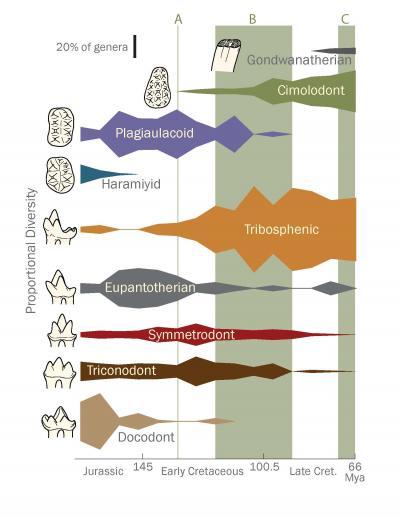The great angiosperm radiation of the mid-Cretaceous, the dramatic explosion of flowering plant species that occurred about 100 million years ago, is thought to have been good news for evolving mammals, providing them with new options for food and habitat.
Previous literature suggested the spread of angiosperms, along with the evolution of pollinating insects, may have spurred an increase in the diversity of mammals. The idea made sense: The radiation would likely have resulted in more food sources from seeds, fruits, leaves and insects.
Not always.
"At the middle of the Cretaceous, a time when the early angiosperms are radiating, we find a surprising decrease in the diversity of mammals," says lead author David Grossnickle, a doctoral student at the University of Chicago . "It's not until the end of the Cretaceous, close to the time of the extinction of the dinosaurs, that we actually see a rebound in mammalian diversity and the first appearance of purely herbivorous mammals."

This figure shows a decline in mammal variety by dental type in the mid-Cretaceous. Note the increase, however, in mammals with tribosphenic molars, small insectivores that gave rise to modern-day mammals. Credit: David Grossnickle
Grossnickle and P. David Polly, a professor in the Department of Geological Sciences at Indiana University Bloomington, say theirs is the first paleontological examination of its kind, tracking morphological, taxonomic and dietary changes of mammals during the mid-Cretaceous and they found that while the number of mammal species may have increased, their variety decreased. Most of the mammals that survived were small, insect-eating animals.
"From the fossil record, the time of the angiosperm radiation doesn't look like a very good time for mammals," Grossnickle said. "There's not as much variation as there was before and after that time, and there's not as much as you would expect at a time when angiosperms were radiating."
The study examined mammalian evolution associated with changing diets through a detailed analysis of the size and shape of jaws from the fossil record. The researchers also used dental function and molar size to chart changes in mammal morphology.
They found that one group of mammals, while mostly small and morphologically similar, did well in the mid-Cretaceous. Those were early therians, which gave rise to most modern mammals, including humans.
"Without the ecological changes brought about by the Cretaceous radiation of flowering plants," Grossnickle said, "the world would be a very different place and may not have triggered crucial adaptations of our clever primate ancestors."
Citation: David M. Grossnickle and P. David Polly, 'Mammal disparity decreases during the Cretaceous angiosperm radiation', Proc. R. Soc. B. 2013 280 1771 20132110 October 2, 2013 doi:10.1098/rspb.2013.2110





Comments